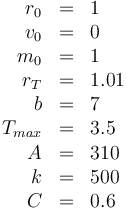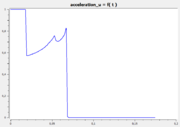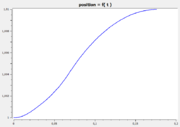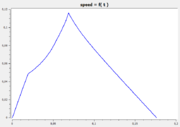Difference between revisions of "Goddart's rocket problem"
From mintOC
FelixMueller (Talk | contribs) (→Mathematical formulation) |
FelixMueller (Talk | contribs) (→Mathematical formulation) |
||
| Line 21: | Line 21: | ||
& \dot{v}(t) & = & -\frac{1}{r(t)^2} + \frac{1}{m(t)} (T_{max}u(t)-D(r,v)) \\[1.5ex] | & \dot{v}(t) & = & -\frac{1}{r(t)^2} + \frac{1}{m(t)} (T_{max}u(t)-D(r,v)) \\[1.5ex] | ||
& \dot{m}(t) & = & -b T_{max} u(t), \\ | & \dot{m}(t) & = & -b T_{max} u(t), \\ | ||
| − | & u( | + | & u(t) &\in& [0,1] \\ |
& r(0) &=& r_0, \\ | & r(0) &=& r_0, \\ | ||
& v(0) &=& v_0, \\ | & v(0) &=& v_0, \\ | ||
Revision as of 13:07, 19 January 2016
In Goddart's rocket problem we model the ascent (vertical; restricted to 1 dimension) of a rocket. The aim is to reach a certain altitude with minimal fuel consumption. It is equivalent to maximize the mass at the final altitude.
Contents
[hide]Variables
The state variables  describe the altitude(radius), speed and mass.
describe the altitude(radius), speed and mass.
The drag is given by

Mathematical formulation
![\begin{array}{llcll}
\displaystyle \min_{m,r,v,u,T} & -m(T)\\[1.5ex]
\mbox{s.t.} & \dot{r}(t) & = & v, \\
& \dot{v}(t) & = & -\frac{1}{r(t)^2} + \frac{1}{m(t)} (T_{max}u(t)-D(r,v)) \\[1.5ex]
& \dot{m}(t) & = & -b T_{max} u(t), \\
& u(t) &\in& [0,1] \\
& r(0) &=& r_0, \\
& v(0) &=& v_0, \\
& m(0) &=& m_0, \\
& r(T) &=& r_T, \\
& D(r(\cdot),v(\cdot))&\le& C \\
& T free
\end{array}](https://mintoc.de/images/math/5/4/d/54db1fed4baf51ddb6fa38ec0de79fee.png)
Parameters

Reference Solution
The following reference solution was generated using BOCOP. The optimal value of the objective function is -0.63389.
- Reference solution plots
References
The Problem can be found in the BOCOP User Guide.



